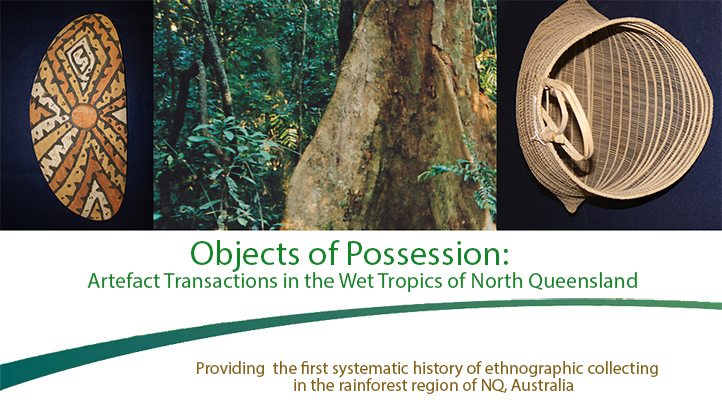
Above: Archibald Meston (right foreground with cap and moustache) at a base camp on his 1904 ascent of Mount Bellenden Ker, in a photograph illustrating his varied collecting interests. As a natural history collector, Meston relied on Aboriginal assistants such as the women depicted here bearing botanical specimens. As an ethnographic collector, his eyes were as much on the women’s bicornual baskets as on the plants they contained. Source: Archibald Meston Photographic Album c.1904, John Oxley Library, API-3.
Author: Russell McGregor
Collector: Archibald Meston
Born: Donside, Aberdeenshire, Scotland, 1851
Died: Brisbane, Queensland, 11 March 1924
Active : As an ethnographic collector, Meston was active in the Wet Tropics region in the 1880s, 1890s and the first few years of the 1900s.
Background biography:
Archibald Meston was a largely self-educated man, fond of displaying his erudition in innumerable stories, speeches, articles, books and poems. His life encompassed careers as a politician, journalist, newspaper editor, explorer, geographer, historian, naturalist, public servant, Protector of Aboriginals, showman, sugar plantation manager and farmer. Among these activities he also collected Aboriginal artefacts, from the rainforests of North Queensland as well as from other parts of the colony. His collecting practices were as eclectic as the man himself.
In his writings on Aboriginal topics – as on all other matters – Meston set himself up as the expert. Lacking formal training in anthropology, Meston claimed the validation of experience. He claimed to have learned in childhood the language of the Aboriginal people of the Clarence River region of northern New South Wales, and his later writings on Aboriginal issues were buttressed with frequent references what he said he had been told by local Aboriginal elders. Linguistic interests persisted throughout his life, Meston collecting vocabularies from numerous Aboriginal languages, including many from North Queensland.
Meston’s representations of Aboriginal people combined admiration with deprecation in ways many readers today find disconcerting. In his lushly Romantic style, Meston lauded Aboriginal peoples’ courage and heroism, their skills in hunting and living off the land, their sense of connectedness with country and spirituality. He especially admired the masculine physicality he saw in Aboriginal men, and praised their martial qualities in imagery reminiscent of earlier Romantic writers on the Scottish Highlanders. As a gesture of respect, Meston urged official recognition of Aboriginal names for geographical features, even those that already had European names. Thus, for example, he recommended the name ‘Wooroonooran’ over ‘Mount Bellenden Ker’ and ‘Chooreechillum’ over ‘Bartle Frere’.
Alongside representations of the Noble Savage, Meston invoked quite different images of Aboriginal people as inept and incompetent. His assumption of their need for firm paternal guidance underpinned his 1895 ‘Proposed System for their Improvement and Preservation’, which provided the foundations for Queensland’s Aboriginals Protection and Restriction of the Sale of Opium Act, 1897. Like most of his contemporaries Meston maintained that the Aboriginal race was doomed to imminent extinction. Nostalgic elegies for a dying people thread through his writings on the Aborigines, compromising the more positive portrayals he made of Aboriginal cultures and ways of life.
Like many collectors of Aboriginal artefacts in the late nineteenth century, Meston believed that he was among the last who would be able to collect such items, for their makers would soon be extinct. He appreciated the aesthetic as well as the utilitarian qualities of the artefacts he collected, but made no attempt to scientifically analyse or categorise them in the manner of contemporaries such as Walter Roth. Rather, his collecting was guided by an autodidact’s assessment of which implements and weapons best exemplified the Aboriginal way of life and an entrepreneur’s eye for what might sell on the market.
